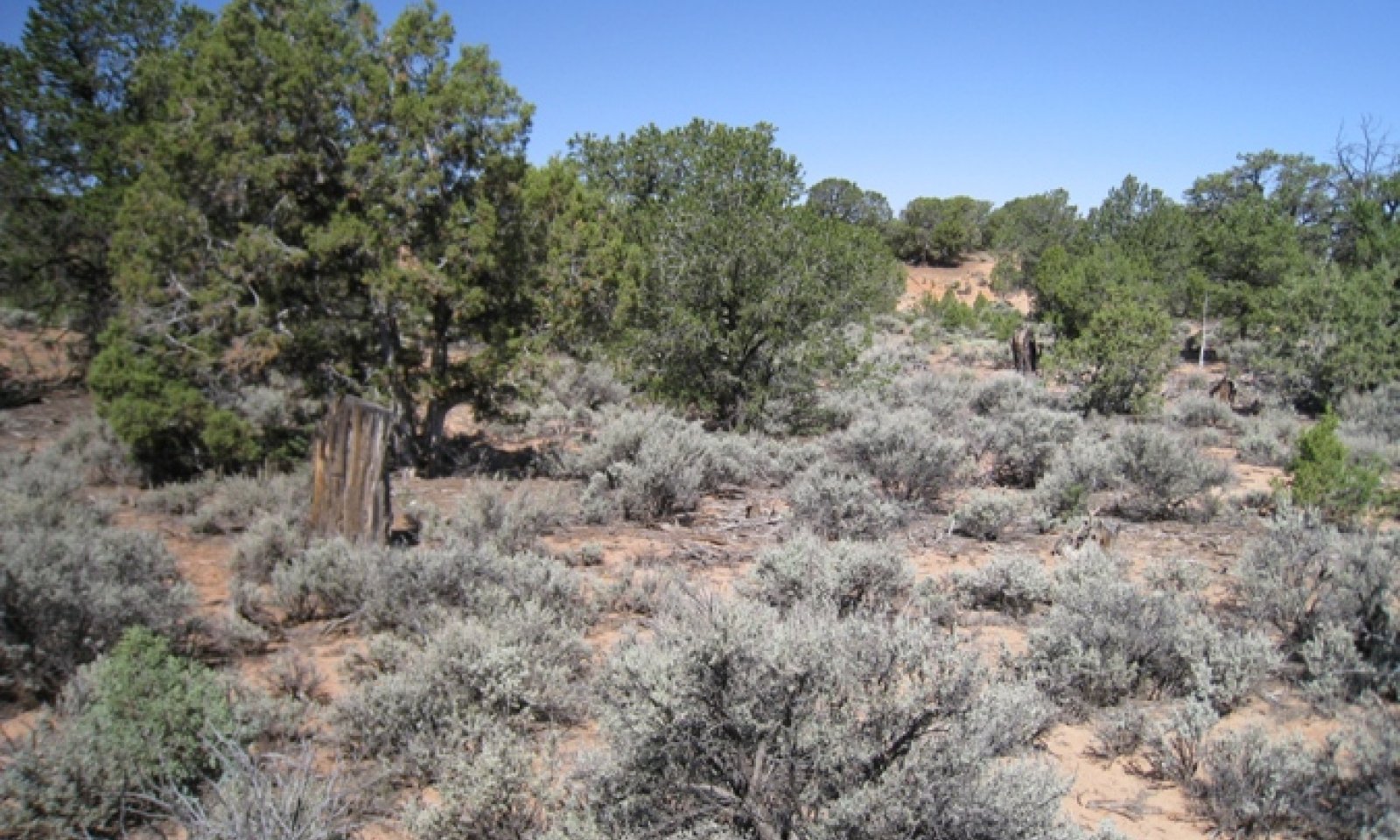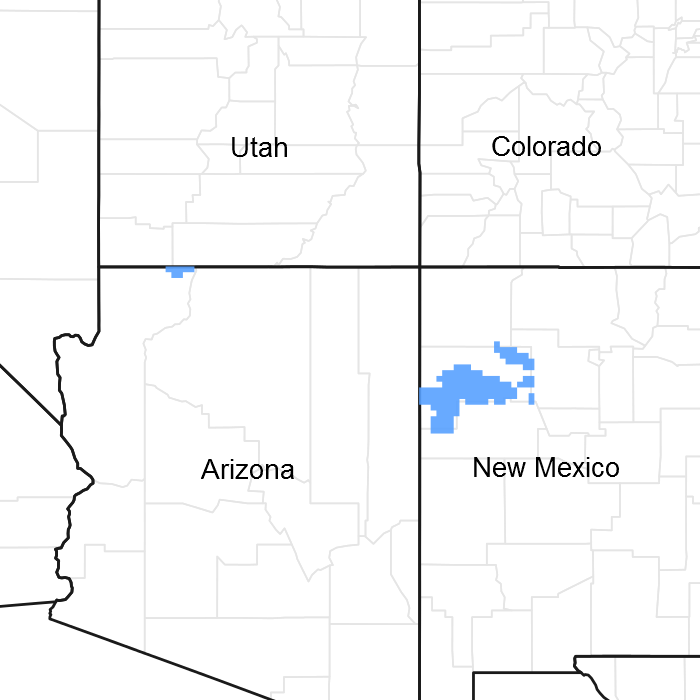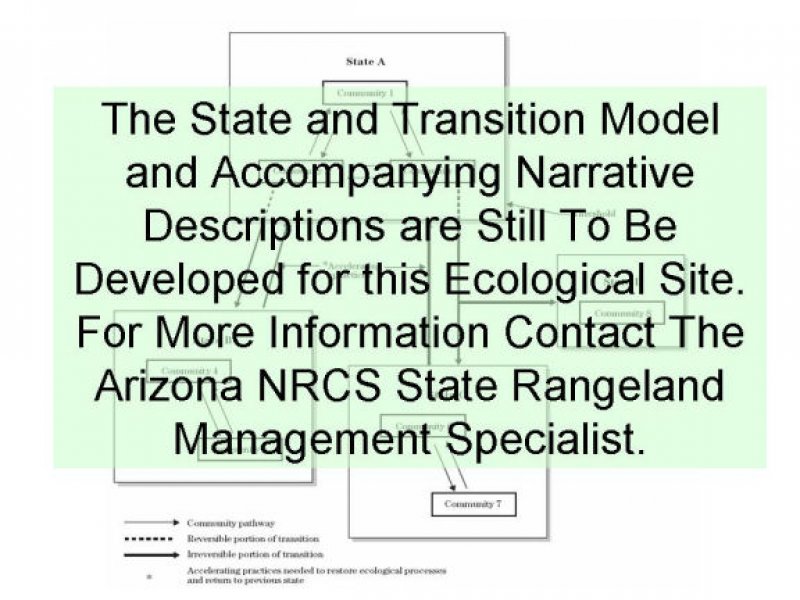

Natural Resources
Conservation Service
Ecological site DX035X03G618
Sandy Upland 13-17" p.z. Moderately Deep
Accessed: 12/06/2025
General information
Provisional. A provisional ecological site description has undergone quality control and quality assurance review. It contains a working state and transition model and enough information to identify the ecological site.

Figure 1. Mapped extent
Areas shown in blue indicate the maximum mapped extent of this ecological site. Other ecological sites likely occur within the highlighted areas. It is also possible for this ecological site to occur outside of highlighted areas if detailed soil survey has not been completed or recently updated.
MLRA notes
Major Land Resource Area (MLRA): 035X–Colorado Plateau
AZ CRA 35.6 - Colorado Plateau Pinyon-Juniper-Sagebrush
Elevations range from 5500 to 7000 feet and precipitation averages 13 to 17 inches per year. Vegetation includes pinyon, juniper, big sagebrush, cliffrose, Mormon tea, muttongrass, prairie junegrass, squirreltail, western wheatgrass, and blue grama. The soil temperature regime is mesic and the soil moisture regime is aridic ustic. This unit occurs within the Colorado Plateau Physiographic Province and is characterized by a sequence of flat to gently dipping sedimentary rocks eroded into plateaus, valleys and deep canyons. Sedimentary rock classes dominate the plateau with volcanic fields occurring for the most part near its margin.
Associated sites
| R035XF607AZ |
Sandy Upland 13-17" p.z. Sandy Upland, 13-17" p.z. |
|---|
Similar sites
| F035XC323AZ |
Sandy Upland 10-14" p.z. (JUOS) Sandy Upland (JUOS) 10-14" p.z. |
|---|
Table 1. Dominant plant species
| Tree |
(1) Pinus edulis |
|---|---|
| Shrub |
(1) Purshia tridentata |
| Herbaceous |
(1) Muhlenbergia pungens |
Legacy ID
R035XF618AZ
Physiographic features
This site is found on plateaus and mesas of Navajo sandstone formation. The topography is generally undulating. The site may occur on either shoulders or summits. Outcrops of sandstone are normally found in association with this site.
Table 2. Representative physiographic features
| Landforms |
(1)
Plateau
(2) Mesa |
|---|---|
| Flooding frequency | None |
| Ponding frequency | None |
| Elevation | 1,707 – 1,951 m |
| Slope | 1 – 10% |
| Aspect | Aspect is not a significant factor |
Climatic features
The climate of this land resource unit is semiarid with warm summers and cool winters. The mean annual precipitation ranges from 13 – 17 inches, but it is very erratic, often varying substantially from year to year. The majority of the precipitation comes from October through April. This precipitation comes as gentle rain or snow from frontal storms coming out of the Pacific Ocean. Snow is common from November through February. Generally no more than a few inches of snow accumulates, melting within a few days, but may last a week or more. The remaining precipitation comes from July through September as spotty, unreliable and sometimes violent thunderstorms. The moisture for this precipitation originates in the Gulf of Mexico (and the Pacific Ocean in the fall) and flows into the area on the north end of the Mexican monsoon. Late May through late June is generally a dry period. The mean annual air temperature ranges from 47 to 49 degrees Fahrenheit (F). The frost-free period (air temperature > 32 degrees F) ranges from 113 to 144 days (@ 50 percent probability). Strong winds are common, especially in the spring.
Table 3. Representative climatic features
| Frost-free period (average) | 144 days |
|---|---|
| Freeze-free period (average) | 160 days |
| Precipitation total (average) | 432 mm |
Figure 2. Monthly precipitation range
Figure 3. Monthly average minimum and maximum temperature
Influencing water features
Soil features
The soils characterizing this site are moderately deep over sandstone bedrock. They are well drained. The surface layer is about 8 inches thick with a texture of fine sand. The subsurface texture is also fine sand. The available water capacity is very low to low.
Typical taxonomic units include:
SSA-625 Mohave County NE part MU 53 Royosa & Tonalea;
SSA-711 Navajo Mountain Area MU 4 Aridic Ustorthents and Royosa.
Table 4. Representative soil features
| Parent material |
(1)
Eolian deposits
–
sandstone
|
|---|---|
| Surface texture |
(1) Fine sand |
| Family particle size |
(1) Sandy |
| Drainage class | Somewhat excessively drained to excessively drained |
| Permeability class | Very rapid |
| Soil depth | 102 cm |
| Surface fragment cover <=3" | 0% |
| Surface fragment cover >3" | 0% |
| Available water capacity (0-101.6cm) |
6.35 – 12.7 cm |
| Calcium carbonate equivalent (0-101.6cm) |
0% |
| Electrical conductivity (0-101.6cm) |
0 – 2 mmhos/cm |
| Sodium adsorption ratio (0-101.6cm) |
0 |
| Soil reaction (1:1 water) (0-101.6cm) |
7.4 – 7.8 |
| Subsurface fragment volume <=3" (Depth not specified) |
0% |
| Subsurface fragment volume >3" (Depth not specified) |
0% |
Ecological dynamics
This site is interspersed with the shallower Sandstone Upland, 13-17" p.z. ecological site and rock outcrop. In areas where this site is in small patches the canopy cover trees will increase. In those areas where it is comprised of larger blocks of moderately deep soil it may be more savanah-like.
State and transition model

More interactive model formats are also available.
View Interactive Models
More interactive model formats are also available.
View Interactive Models
Click on state and transition labels to scroll to the respective text
Ecosystem states
State 1 submodel, plant communities
State 1
Historic Climax Plant Community
Community 1.1
Historic Climax Plant Community

Figure 4. Sandy Upland 13-17" p.z. Moderately Deep
The aspect of this site is a mix of Colorado pinyon and Utah juniper with scattered Gambel oak and an occasional ponderosa pine. Common understory plants include greenleaf manzanita, Utah serviceberry sandhill muhly, blue grama and Indian ricegrass.
Figure 5. Annual production by plant type (representative values) or group (midpoint values)
Table 5. Annual production by plant type
| Plant type | Low (kg/hectare) |
Representative value (kg/hectare) |
High (kg/hectare) |
|---|---|---|---|
| Tree | 713 | – | 861 |
| Shrub/Vine | 161 | – | 336 |
| Grass/Grasslike | 67 | – | 175 |
| Forb | 40 | – | 108 |
| Total | 981 | – | 1480 |
Figure 6. Plant community growth curve (percent production by month). AZ3561, 35.6 13-17" p.z. all sites. Growth begins in the spring and continues into the fall..
| Jan | Feb | Mar | Apr | May | Jun | Jul | Aug | Sep | Oct | Nov | Dec |
|---|---|---|---|---|---|---|---|---|---|---|---|
| J | F | M | A | M | J | J | A | S | O | N | D |
| 0 | 1 | 5 | 16 | 17 | 15 | 15 | 15 | 11 | 5 | 0 | 0 |
Additional community tables
Table 6. Community 1.1 plant community composition
| Group | Common name | Symbol | Scientific name | Annual production (kg/hectare) | Foliar cover (%) | |
|---|---|---|---|---|---|---|
|
Grass/Grasslike
|
||||||
| 1 | Perennial Cool Season Grasses | 13–67 | ||||
| Indian ricegrass | ACHY | Achnatherum hymenoides | 13–27 | – | ||
| threeawn | ARIST | Aristida | 0–13 | – | ||
| squirreltail | ELELE | Elymus elymoides ssp. elymoides | 0–13 | – | ||
| needle and thread | HECOC8 | Hesperostipa comata ssp. comata | 0–13 | – | ||
| western wheatgrass | PASM | Pascopyrum smithii | 0–13 | – | ||
| muttongrass | POFE | Poa fendleriana | 0–13 | – | ||
| 2 | Perennial Warm Season Grasses | 54–108 | ||||
| sandhill muhly | MUPU2 | Muhlenbergia pungens | 40–67 | – | ||
| blue grama | BOGR2 | Bouteloua gracilis | 13–27 | – | ||
| spike muhly | MUWR | Muhlenbergia wrightii | 0–13 | – | ||
| James' galleta | PLJA | Pleuraphis jamesii | 0–13 | – | ||
| sand dropseed | SPCR | Sporobolus cryptandrus | 0–13 | – | ||
|
Forb
|
||||||
| 3 | Perennial Forbs | 40–108 | ||||
| buckwheat | ERIOG | Eriogonum | 13–27 | – | ||
| beardtongue | PENST | Penstemon | 13–27 | – | ||
| spiny phlox | PHHO | Phlox hoodii | 0–13 | – | ||
| ragwort | SENEC | Senecio | 0–13 | – | ||
| fiddleneck | AMSIN | Amsinckia | 0–13 | – | ||
| white sagebrush | ARLU | Artemisia ludoviciana | 0–13 | – | ||
| pale bastard toadflax | COUMP | Comandra umbellata ssp. pallida | 0–13 | – | ||
| largeleaf springparsley | CYME | Cymopterus megacephalus | 0–13 | – | ||
|
Shrub/Vine
|
||||||
| 4 | Shrubs | 157–325 | ||||
| Gambel oak | QUGA | Quercus gambelii | 40–81 | – | ||
| Utah serviceberry | AMUT | Amelanchier utahensis | 40–67 | – | ||
| Wyoming big sagebrush | ARTRW8 | Artemisia tridentata ssp. wyomingensis | 27–54 | – | ||
| antelope bitterbrush | PUTR2 | Purshia tridentata | 27–54 | – | ||
| mormon tea | EPVI | Ephedra viridis | 13–40 | – | ||
| greenleaf manzanita | ARPA6 | Arctostaphylos patula | 13–27 | – | ||
| rubber rabbitbrush | ERNA10 | Ericameria nauseosa | 0–13 | – | ||
| snakeweed | GUTIE | Gutierrezia | 0–13 | – | ||
| Sonoran scrub oak | QUTU2 | Quercus turbinella | 0–13 | – | ||
| spineless horsebrush | TECA2 | Tetradymia canescens | 0–13 | – | ||
| 5 | Yucca and Yucca Like | 27–40 | ||||
| narrowleaf yucca | YUAN2 | Yucca angustissima | 27–40 | – | ||
| banana yucca | YUBA | Yucca baccata | 0–13 | – | ||
| 6 | Cacti | 13–27 | ||||
| beavertail pricklypear | OPBA2 | Opuntia basilaris | 13–27 | – | ||
| hedgehog cactus | ECHIN3 | Echinocereus | 0–13 | – | ||
|
Tree
|
||||||
| 7 | Trees | 673–852 | ||||
| Utah juniper | JUOS | Juniperus osteosperma | 336–404 | – | ||
| twoneedle pinyon | PIED | Pinus edulis | 336–404 | – | ||
| ponderosa pine | PIPO | Pinus ponderosa | 0–67 | – | ||
Interpretations
Animal community
The suitability for livestock grazing is fair. Loose sand makes travel difficult.
Supporting information
Type locality
| Location 1: Mohave County, AZ | |
|---|---|
| Township/Range/Section | T41 N. R5 W. S34 |
| General legal description | Arizona, Mohave County, Moccasin 7 1/2 min. quad., Sec. 34, T. 41 N., R. 5 W., about 4 miles northwest of Moccasin, Arizona. |
Other references
Information and updates collected during 2009-2010 for this ESD was conducted as part of an Interagency Technical Assistance Agreement between the Bureau of Indian Affairs–Navajo Region and the NRCS-Arizona.
Contributors
Larry D. Ellicott
Stephen Cassady
Steve Cassady
Rangeland health reference sheet
Interpreting Indicators of Rangeland Health is a qualitative assessment protocol used to determine ecosystem condition based on benchmark characteristics described in the Reference Sheet. A suite of 17 (or more) indicators are typically considered in an assessment. The ecological site(s) representative of an assessment location must be known prior to applying the protocol and must be verified based on soils and climate. Current plant community cannot be used to identify the ecological site.
| Author(s)/participant(s) | |
|---|---|
| Contact for lead author | |
| Date | |
| Approved by | |
| Approval date | |
| Composition (Indicators 10 and 12) based on | Annual Production |
Indicators
-
Number and extent of rills:
-
Presence of water flow patterns:
-
Number and height of erosional pedestals or terracettes:
-
Bare ground from Ecological Site Description or other studies (rock, litter, lichen, moss, plant canopy are not bare ground):
-
Number of gullies and erosion associated with gullies:
-
Extent of wind scoured, blowouts and/or depositional areas:
-
Amount of litter movement (describe size and distance expected to travel):
-
Soil surface (top few mm) resistance to erosion (stability values are averages - most sites will show a range of values):
-
Soil surface structure and SOM content (include type of structure and A-horizon color and thickness):
-
Effect of community phase composition (relative proportion of different functional groups) and spatial distribution on infiltration and runoff:
-
Presence and thickness of compaction layer (usually none; describe soil profile features which may be mistaken for compaction on this site):
-
Functional/Structural Groups (list in order of descending dominance by above-ground annual-production or live foliar cover using symbols: >>, >, = to indicate much greater than, greater than, and equal to):
Dominant:
Sub-dominant:
Other:
Additional:
-
Amount of plant mortality and decadence (include which functional groups are expected to show mortality or decadence):
-
Average percent litter cover (%) and depth ( in):
-
Expected annual annual-production (this is TOTAL above-ground annual-production, not just forage annual-production):
-
Potential invasive (including noxious) species (native and non-native). List species which BOTH characterize degraded states and have the potential to become a dominant or co-dominant species on the ecological site if their future establishment and growth is not actively controlled by management interventions. Species that become dominant for only one to several years (e.g., short-term response to drought or wildfire) are not invasive plants. Note that unlike other indicators, we are describing what is NOT expected in the reference state for the ecological site:
-
Perennial plant reproductive capability:
Print Options
Sections
Font
Other
The Ecosystem Dynamics Interpretive Tool is an information system framework developed by the USDA-ARS Jornada Experimental Range, USDA Natural Resources Conservation Service, and New Mexico State University.
Click on box and path labels to scroll to the respective text.